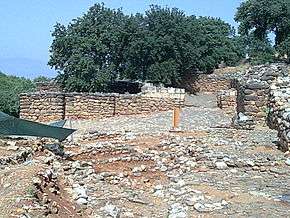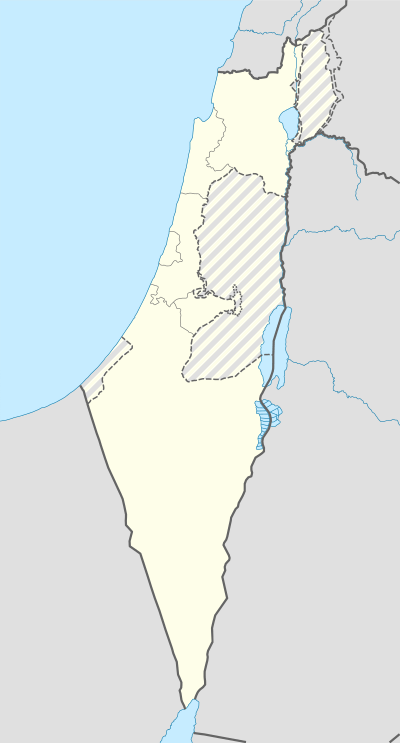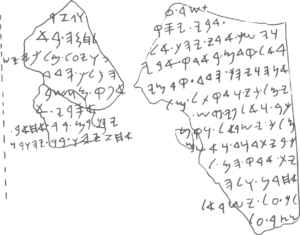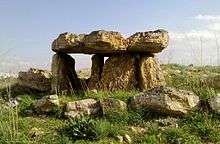Dan (ancient city)
| תל דן | |
 Tel Dan - Remains of the Iron Age (Israelite) Gate on the City's South Wall | |
 Shown within Israel | |
| Alternate name | تل القاضي |
|---|---|
| Location | Israel |
| Coordinates | 33°14′56″N 35°39′07″E / 33.249°N 35.652°E |
| Type | conserved ruins |
| History | |
| Founded | c. 4500 BC |
| Abandoned | c. 733 BC |
| Periods | Neolithic, Bronze, Iron |
| Cultures | Neolithic, Canaanite, Israelite |
| Site notes | |
| Public access | yes |
| Website | Tel Dan Nature Reserve |
Dan (Hebrew: דן), is a city mentioned in the Hebrew Bible, described as the northernmost city of the Kingdom of Israel,[1] and belonging to the tribe of Dan. The city is identified with a tell located in northern Israel known as Tel Dan (תל דן "Mound of Dan") in Hebrew, or Tell el-Qadi (تل القاضي "Mound of the Judge") in Arabic, .
Identification and names
The American naval officer William F. Lynch identified Tell el Kadi as the site of ancient Dan in 1849.[2] Three years later, Edward Robinson also made the same identification [3] and this identification is now securely accepted.
The Hebrew Bible states that prior to its conquest by the tribe of Dan the site was known as Laish with variant spellings within the Books of Joshua, Judges and Isaiah.[4] In Joshua 19:47 it is called Leshem or Lesem,[5] which means "jewel".[6] Isaiah 10:30 has the alternative name Laishah in a number of translations.[7] Tel Dan is a modern Israeli name for the site.[6]
Geography
Dan is situated in Israel, in the area known as the Galilee Panhandle. To the west is the southern part of Mount Lebanon; to the east and north are the Hermon mountains. Melting snow from the Hermon mountains provides the majority of the water of the Jordan River, and passes through Dan, making the immediate area highly fertile. The lush vegetation that results makes the area around Dan seem somewhat out of place in the otherwise arid region around it. Due to its location close to the border with Syria and Lebanon at the far north of the territory which fell under the British Mandate of Palestine, the site has a long and often bitterly contested modern history, most recently during the 1967 Six-Day War.
History and archaeology
According to the archaeological excavations at the site, the town was originally occupied in the late Neolithic era (c 4500 BCE), although at some time in the fourth millennium BC it was abandoned, for almost 1,000 years.[8]
Bronze Age
According to the Book of Judges: prior to the Tribe of Dan occupying the land, the town was known as Laysha (Judges 18:7 and Isaiah 10:30, לישה) or Laish (elsewhere Judges 18) - which root the Hebrew poets applied also to the lion (Job 4:11, Proverbs 30:30 and Isaiah 30:5).[9] The Egyptians cursed Laish in the Execration Tablets; later, Tuthmosis III conquered the town "ra-wy-sa" along others.[10] Laish was allied with the Sidonians. This might indicate they were Phoenicians (Sidonians were Phoenicians from the city of Sidon), who may or may not have been Canaanite. The alliance offered little practical benefit due to the remoteness of Laish from Sidon, and the intervening Lebanon mountains. The town was also isolated from the Assyrians and Aram by the Hermon mountains; the Septuagint mentions that the town was unable to have an alliance with the Aramaeans. The masoretic text does not mention the Aramaeans, but instead states that the town had no relationship with any man - textual scholars believe that this is a scribal error, with adham (man) being a mistake for Aram.[11]
According to Judges concerning Micah's Idol, the Tribe of Dan did not at that point have any territory to their name (Judges 18:1), and so, after scouting out the land, eventually decided to attack Laish, as the land around it was fertile, and the town was demilitarised. Most Biblical scholars now believe that the Tribe of Dan originated as one of the Sea Peoples, hence remaining on their ships in the early Song of Deborah, and not having Israelite land to their name,[12][13] though conservative scholars argue that the Tribe of Dan migrated because they were forced out of their original lands by the Philistines.

The Bible describes the Tribe of Dan brutally defeating the people of Laish and burning the town to the ground, and then building their own town in the same spot. The narrative states that Laish subsequently became known as Dan, after the name of the tribe, and that it housed a sanctuary filled with idols, which remained in use until the time of captivity of the land and the time that the house of God ceased to be in Shiloh. Scholars think that the former refers to the Assyrian conquest of the Kingdom of Israel by Tiglath-pileser III in 733/732 BCE, and that the latter refers to the time of Hezekiah's religious reform;[13] an alternative possibility, however, supported by a minority of scholars, is that time of captivity of the land is a typographic error and should read time of captivity of the ark, referring to the battle of Eben-Ezer, and the Philistine capture of the Ark, and that the ceasing of the house of God being in Shiloh refers to this also.[14]
The excavators of Tel Dan uncovered a city gate made of mud bricks on top of megalithic basalt standing stones,[15] estimated to have been built around 1750 BC. Its popular name is Abraham's Gate, due to the biblical story that Abraham traveled to Dan to rescue his nephew Lot. Genesis 14:14:
"And when Abram heard that his brother was taken captive, he armed his trained servants, born in his own house, three hundred and eighteen, and pursued them unto Dan."
The gate was restored in the late 2000s, and has become a popular tourist attraction.[16]
Iron Age
According to 2 Kings 10:29 and 2 Chronicles 13:8, Jeroboam erected two golden calves as gods in Bethel and Dan. Textual scholars believe that this is where the Elohist story of Aaron's Golden Calf actually originates, due to opposition in some sections of Israelite society (including the Elohist themselves) to the seeming idol-worship of Jeroboam.[17] However, Biblical scholars believe that Jeroboam was actually trying to outdo the sanctuary at Jerusalem (Solomon's Temple), by creating a seat for God that spanned the whole kingdom of Israel, rather than just the small space above the Ark of the Covenant in Jerusalem; the seat for God in the Jerusalem sanctuary was represented by a cherubim on either side, while scholars believe that Jeroboam was using the calves to represent the sides of his seat for God - implying his whole kingdom was equal in holiness to the Ark[17]

Within the remains of the city wall, close to the entrance of the outer gate, parts of the Tel Dan Stele were found.[18] The basalt stone bears an Aramaic inscription referring to one of the kings of Damascus; the excavators of the site believe that the king it refers to is Hazael (c 840 BCE),[19] though a minority argue that it instead refers to Ben-Hadad (c 802 BCE).[20] A small part of the inscription remains, with text containing the letters 'ביתדוד' (BYTDWD), which some archaeologists agree refers to House of David (Beth David in Hebrew.[21][22] In the line directly above, the text reads 'MLK YSR'L', i.e. "King of Israel". Hebrew script from the era is vowel-less), which would make the inscription the first time that the name David has been found at an archaeological site dating before 500 BCE.
Dan suffered in the era of expansion by the Aramaeans, due to being the closest city to them in the kingdom of Israel. The several incursions indicated by the Book of Kings suggest that Dan changed hands at least four times between the Kingdom of Israel and Aramaeans, around the time that Israel was ruled by Ahab and the Aramaeans by Ben Hadad I, and their successors. Around this time, the Tel Dan stele was created by the Aramaeans, during one of the periods of their control of Dan. When the Assyrian empire expanded to the south, the kingdom of Israel initially became a vassal state, but after rebelling, the Assyrians invaded, the town fell to Tiglath-pileser III in 733/732 BCE.
In 1992, in order to tidy up the site for presentation to visitors, a heap of debris was removed which dated from the time of the Assyrian destruction of the city by Tiglath-pileser III in 733/2 BCE. A hitherto unknown earlier gateway to the city was uncovered. The entrance complex led to a courtyard paved with stone with a low stone platform. In the 9th century BCE, the podium was enlarged, and major fortifications were built, a city wall with buttresses and a complex gate. The podium was enlarged further in the 8th century BCE by Jeroboam II, then destroyed by Tiglath-pileser III.[23]
Later periods
During the Persian, Hellenistic, and Roman periods, remains indicate that cultic activities continued around the podium (also known as "the High Place").[23]
Tel Dan Nature Reserve
The Tel Dan Nature Reserve was first declared on 39 hectares surrounding the tel in 1974. 9 hectares were added to the reserve in 1989.[24] The Dan River is one of the three water sources of the Jordan River that meet in the northern part of the Hula Valley.[25]
See also
References
- ↑ See verses listed at From Dan to Beersheba
- ↑ W. F. Lynch (1849). Narrative of the United States Expedition to the River Jordan and the Dead Sea. London: Richard Bentley. p. 472.
- ↑ E. Robinson, E. Smith; et al. (1856). Later Biblical Researches in Palestine, and in the Adjacent Regions. Boston: Crocker and Brewster. p. 392.
- ↑ Provan, Iain William; Long, V. Philips; Longman, Tremper (2003). A Biblical History of Israel. Westminster John Knox Press. pp. 181–183. ISBN 0-664-22090-8.
- ↑ "Lesem" in the Douai-Rheims 1899 American Edition
- 1 2 N. P. Lemche (2003). "'House of David', the Tel Dan Inscription(s)". In T. L. Thompson. Jerusalem in Ancient History and Tradition. T&T Clark International. p. 47.
- ↑ e.g. ASV, NIV and NRSV
- ↑ Pottery Neolithic Levels at Tel Dan. Mitekufat Haeven, Journal of the Israel Prehistoric Society 20:91-113. Bar-Yosef, O., Gopher, A., and Nadel, D. 1987.
- ↑ abarim-publications, "Laishah meaning", http://www.abarim-publications.com/Meaning/Laishah.html
- ↑ Wilhelm Max Müller; Henry Frederick Lutz. "GEOGRAPHIC LIST OF TUTHMOSIS III. KARNAK.". Egyptological Researches: Results of a journey in 1904. pp. 80f. second row, #31. Egyptian hieroglyphs - like contemporary Linear A and Linear B - did not distinguish L and R.
- ↑ Arthur Samuel Peake; Matthew Black; Harold Henry Rowley (2001). Peake's Commentary on the Bible. Routledge. ISBN 978-0-415-26355-9. Retrieved 7 September 2010.
- ↑ Yadin, Yigael (1968). "And Dan, Why Did He Remain in Ships?". Australian Journal of Biblical Archaeology.
- 1 2 Stager, Lawrence E. (March–April 1991). "When Canaanites and Philistines Ruled Ashkelon". Biblical Archaeology Review.
- ↑ Jewish Encyclopedia
- ↑ Israel Finkelstein; Amihay Mazar (2007). Brian B. Schmidt, ed. The Quest for the Historical Israel: Debating Archaeology and the History of Early Israel. Society of Biblical Literature. pp. 177–. ISBN 978-1-58983-277-0.
- ↑ Ilani, Ofri; Ashkenazi, Eli (March 18, 2009). "4,000-year-old 'Abraham's Gate' reopened to public after painstaking restoration work". Ha'aretz English Language Edition.
- 1 2 Friedman, Richard Elliot (1989). Who wrote the Bible?. Perennial Library. p. 109. ISBN 978-0-06-097214-1. Retrieved 7 September 2010.
- ↑ http://israel-tourguide.info/2011/03/24/house-of-david-stele
- ↑ Suriano, Mathew J. (2007). "The Apology of Hazael: A Literary and Historical Analysis of the Tel Dan Inscription". 66. Journal of Near Eastern Studies: 163–176.
- ↑ George Athas (2003). The Tel Dan inscription: a reappraisal and a new interpretation. Continuum International Publishing Group. ISBN 978-0-567-04043-5. Retrieved 15 September 2010.
- ↑ Rainey, Anson F. (Nov–Dec 1994). "The House of David and the House of the Deconstructionists". Biblical Archaeological Review, 20:06.
- ↑ Shanks, Hershel (Sep/oct 1999). "Biran at Ninety". Biblical Archaeology Review, 25:03. Check date values in:
|date=(help) - 1 2 Negev, Avraham; Gibson, Shimon (July 2005). Archaeological encyclopedia of the Holy Land. Continuum International Publishing Group. pp. 131–132. ISBN 978-0-8264-8571-7. Retrieved 16 September 2010.
- ↑ "List of National Parks and Nature Reserves" (PDF) (in Hebrew). Israel Nature and Parks Authority. Archived from the original (PDF) on October 7, 2009. Retrieved 2010-09-27.
- ↑ Eretz Magazine
External links
| Wikimedia Commons has media related to Tel Dan. |
- Tel Dan Excavations - official Nelson Glueck School of Biblical Archaeology website
- Tel Dan inscription
- Israel Nature & Natural Parks Protection Authority Site
- 1961 Israeli map of Tel Dan and surrounding area.
